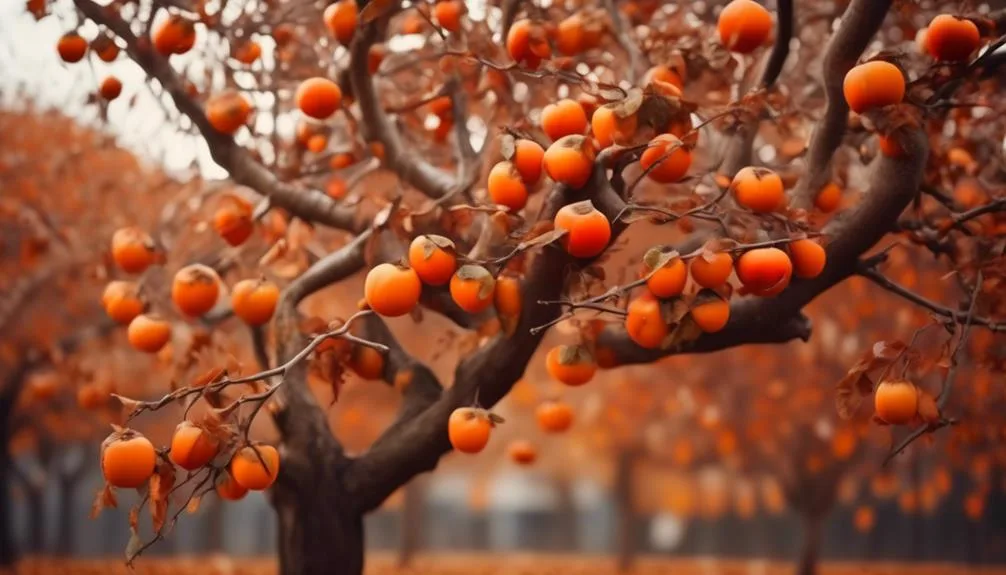As you take a stroll through a peaceful forest in the fall, you can't help but notice the vibrant colors of the changing leaves. Among the trees, the persimmon tree stands out with its bright orange fruits, but something catches your eye. The once green leaves now cover the ground.
Ever wonder why persimmon trees lose their leaves in autumn while evergreen trees don't? The reason behind this lies in the natural cycle of these unique trees, and it's quite fascinating.
Key Takeaways
- Environmental factors play a significant role in the shedding of persimmon tree leaves in autumn.
- Hormonal changes occur in response to environmental cues, leading to leaf shedding and nutrient reabsorption.
- Persimmon trees adapt to cold weather through physiological changes such as cold hardening and modification of cell membranes.
- Leaf drop is an important process for the survival and health of persimmon trees, aiding in nutrient recycling and soil enrichment.
Persimmon Tree Life Cycle
The persimmon tree life cycle begins with the emergence of delicate, pale green leaves and small, unassuming flowers in the early spring.
As the tree progresses through its growth stages, these flowers transform into small, green fruits. Over time, these fruits develop into the iconic orange orbs that the persimmon tree is known for.
The tree undergoes a remarkable transformation during this process, from the initial burst of springtime growth to the eventual fruit production in the fall. This growth cycle is a testament to the tree's resilience and adaptability.
Each stage is a crucial part of the persimmon tree's life cycle, ultimately culminating in the production of its delicious and nutritious fruit.
Environmental Factors and Leaf Shedding
As autumn approaches, environmental factors play a significant role in the shedding of persimmon tree leaves, influencing the tree's transition from lush greenery to the vibrant hues of fall. Nutrient recycling, driven by the changing weather patterns, initiates the process of leaf shedding.
As the days shorten and temperatures drop, the tree begins to reabsorb valuable nutrients from its leaves, preparing for the winter ahead. Soil moisture and temperature fluctuations also contribute to this natural phenomenon. Adequate soil moisture supports the tree's ability to retain its leaves, while rapid changes in temperature signal the tree to shed its leaves in preparation for winter.
These environmental cues trigger the tree to undergo physiological changes, signaling the start of a new phase in its life cycle.
Hormonal Changes in Autumn
Undergoing hormonal changes in response to environmental cues, persimmon trees prepare for the onset of autumn by initiating the process of leaf shedding and nutrient reabsorption. As the days grow shorter and temperatures drop, the trees undergo hormonal regulation, triggering physiological changes that lead to the spectacular display of leaf color before they fall. The decrease in daylight hours signals the tree to produce less chlorophyll, the green pigment responsible for photosynthesis. This reduction in chlorophyll unmasks other pigments present in the leaves, such as carotenoids and anthocyanins, creating the vibrant reds, oranges, and yellows of autumn foliage. Simultaneously, the tree reabsorbs valuable nutrients from the leaves, such as nitrogen and phosphorus, to store them for the upcoming winter, ensuring its survival during the dormant season.
| Leaf Color | Hormonal Regulation |
|---|---|
| Vibrant reds, oranges, and yellows | Triggered by hormonal changes due to decreased daylight hours |
Adaptation to Cold Weather
To thrive in cold weather, persimmon trees undergo physiological changes that enable them to endure the harsh conditions of winter. Winter survival for persimmon trees involves a remarkable temperature response.
As temperatures drop, these trees undergo a process called cold hardening. During this period, the tree accumulates higher levels of soluble sugars, which act as natural antifreeze, protecting the cells from freezing and damage. Additionally, persimmon trees also reduce the water content in their cells, minimizing the risk of ice crystal formation and subsequent cell damage.
Furthermore, the tree's cell membranes undergo modifications to maintain fluidity at lower temperatures. These adaptations allow persimmon trees to withstand freezing temperatures, ensuring their survival through the winter.
Understanding the remarkable adaptations of persimmon trees sheds light on their ability to thrive in cold weather.
Importance of Leaf Drop
During autumn, the persimmon tree strategically sheds its leaves, a vital process that ensures its survival through the winter. The leaf drop is of utmost importance for the seasonal health of the tree. As temperatures drop and daylight lessens, the tree's metabolic processes slow down, making it difficult to sustain the leaves.
By shedding its leaves, the tree conserves energy and redirects nutrients within its system, preparing for the impending cold. This process also aids in nutrient recycling, as the leaves decompose and return essential elements to the soil, enriching it for the next growing season.
Furthermore, leaf drop helps maintain tree health by preventing excessive water loss during winter and minimizing the risk of damage from snow and ice. Ultimately, this natural cycle of shedding and regrowth supports the persimmon tree's long-term survival.
Conclusion
In autumn, persimmon trees shed their leaves as part of their natural life cycle and adaptation to the changing environment.
This process, triggered by hormonal changes, prepares the tree for the cold weather ahead and contributes to the ecosystem by recycling nutrients into the soil.
It's a fascinating example of nature's intricate balance and resilience.

